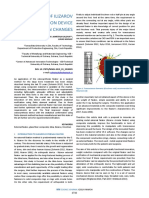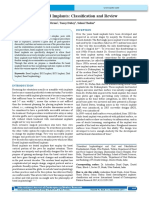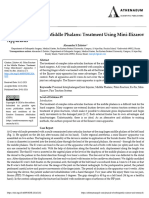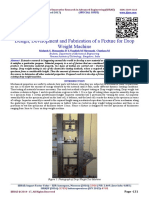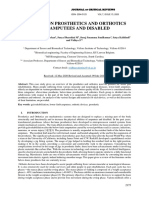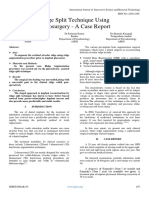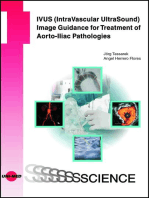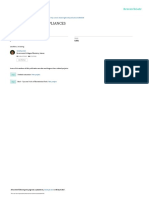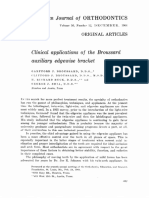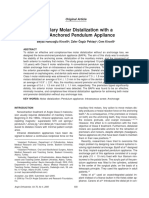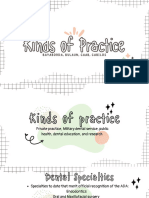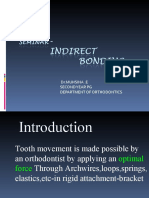Professional Documents
Culture Documents
Ligature Coil Spring A Clinical Tip For Activation of FORSUS
Original Title
Copyright
Available Formats
Share this document
Did you find this document useful?
Is this content inappropriate?
Report this DocumentCopyright:
Available Formats
Ligature Coil Spring A Clinical Tip For Activation of FORSUS
Copyright:
Available Formats
Volume 7, Issue 4, April – 2022 International Journal of Innovative Science and Research Technology
ISSN No:-2456-2165
Ligature Coil Spring: A Clinical Tip for
Activation of FORSUS
Dr. Archana Singh, Dr. Kimi Mittal, Dr. Kamal Bajaj
Abstract:- In Orthodontics, we usually face a challenge problem in the growing age. Power scope and Forsus
to treat skeletal malocclusions. For treating skeletal Fatigue Resistant Device (FORSUS™) are commonly used
problems preferably in Class II skeletal pattern there are devices.
a variety of myofunctional and fixed functional
appliances available in the market and among these few Including all Class II correctors, the FORSUS™ has
gains quite well popularity with ease of treatment with beenaccepted to be the most comfortable for the patient and
desired results and patient’s co-operation. One of the exerts milder forces in comparison to other functional
appliance which is commonly used is Forsus Fatigue appliances, thus allowing the adaptation of the patient’s oral
Resistant Device (FORSUS™), it comes with its easy to musculature and dental changes2. Manufacturers provide
assemble parts and gives a great result. Here we tried to Forsus in multiple sizes according to the requirement;
solve a little problem with a simple hack for activation of consists ofpush rods, spring assembly, and L-pin. This
the appliance which we faced in our practice due to lost appliance is provided with the metallic crimps to
crimps that have come to activate the appliance. accordingly activate the appliance3.
I. INTRODUCTION It has been noticed that sometimes these crimps are lost
during the work, or is not sufficient to activate the appliance
In Orthodontics, skeletal Class II correction is a as per the need. So here we come with a simple clinical tip
challenge in both children and adults. to activate the FORSUS solely or with the combination of
crimps.
In1905, Emil Herbst introduced fixed functional
appliances for patients with temporomandibular joint Design: ligature coil spring as the name describes is made
problems1.But with the advance in time, these appliances up of thick ligature wire (0.011”) and is very easy to
were more widely used for class II correction. There are a fabricate atthe chairside and saves time.
variety of functional appliances available to correct this
II. METHOD
Armamentarium required are- ligature wire spool, ligature wire cutter, artery forceps, and the Forsus appliance kit (fig. 1A,1B)
Fig. 1A: Ligature wire spool, Ligature wire cutter, Artery forcep Fig.1B : FORSUS appliance tools
A ligature coil spring is fabricated over the push rod of the appliance by using an artery forcep and both ends are tied together
and covered under the spring so it won’t pinch the patient. (fig. 2).
Fig. 2: Ligature coil spring over the push rod (Ligature coil spring in upper left corner)
IJISRT22APR897 www.ijisrt.com 436
Volume 7, Issue 4, April – 2022 International Journal of Innovative Science and Research Technology
ISSN No:-2456-2165
All three parts of FORSUS were assembled with a ligature coil spring over the pushrod and placed in the patient’s mouth and
checked for activation. (Fig3A,3B,3C).
Fig. 3A: pre treatment
Fig. 3B: Insertion of FORSUS Fig 3C: Activation of FORSUS with
Ligature Coil spring
A Good pleasant profile of the patient can be appreciated (Before and after placement of Forsusappliance)(Fig.4)
Fig. 4: Profile picture of the patient, Before and After FORSUS
Activation
IJISRT22APR897 www.ijisrt.com 437
Volume 7, Issue 4, April – 2022 International Journal of Innovative Science and Research Technology
ISSN No:-2456-2165
Facial asymmetry correction after placement of Forsus appliance(Fig. 5).
Fig. 5: Before and After frontal photo of the patient.
III. DISCUSSION
Activation of Fixed Functional Appliance is sometimes
problematic if we lost the crimps and to activate with the
ligature coil spring seems easy and an effective alternative.
We have also come across different methods of
activation.We have tried multiple methods of activation with
acrylic beads or activation with rectangular wire,which can
be a little difficult to make appropriate spring around the
pushrod due to its thickness and stiffness and it also causes
discomfort to the patient due to impinging ends. On the
other hand, a thick ligature wire serves the purpose quite
effectively as it won’t distort during the process and is
moldable enough to make an accurate spring around the rod.
REFERENCES
[1.]Proffit WR, Fields HW, Moray LJ. Prevalence of
malocclusion and orthodontic treatment need in the
United States: estimates from the NHANES-III survey.
Int J Adult OrthodOrthogn Surg.1998;13:97–106.
[2.]Woodside DG, Metaxa A, Altuna G. the influence of
functional appliance therapy on glenoid fossa
remodeling. Am JOrthod Dentofacial Orthop
1987;92:181-198.
[3.]Vogt W. The Forsus fatigue resistant device. JCO 2006
Jun 40(6);368-77.
[4.]SUMIT YADAV, MADHUR UPADHYAY, K.
NAGARAJ, SAMEER PATIL, Tips for using Fixed
Functional Appliances. 2006 JCO. www.jco-online.com.
IJISRT22APR897 www.ijisrt.com 438
You might also like
- Hybrid Appliances An UpdateDocument7 pagesHybrid Appliances An UpdateSushma DhimanNo ratings yet
- The Forsus Fatigue Resistant Device: Better Than Elastics For Class IIDocument5 pagesThe Forsus Fatigue Resistant Device: Better Than Elastics For Class IIAlvaro ChacónNo ratings yet
- Transforce Appliance - A Review of LiteratureDocument3 pagesTransforce Appliance - A Review of LiteratureInternational Journal of Innovative Science and Research TechnologyNo ratings yet
- Dental Force Measurement Using Peizoelectric SensorsDocument6 pagesDental Force Measurement Using Peizoelectric SensorsIJRASETPublicationsNo ratings yet
- Mmscience 2019 03 Innovation of Ilizarov Stabilization Device With The Design ChangesDocument7 pagesMmscience 2019 03 Innovation of Ilizarov Stabilization Device With The Design ChangesZilbran BerontaxNo ratings yet
- 57 - Fabrication and Analysis of Chairless Chair 1 - 1Document9 pages57 - Fabrication and Analysis of Chairless Chair 1 - 1Akash Chiman100% (1)
- Basal Osseointegrated Implants ClassificDocument7 pagesBasal Osseointegrated Implants ClassificAnkur SaladaNo ratings yet
- Finite Element Analysis of Locking Compression Plate in BendingDocument31 pagesFinite Element Analysis of Locking Compression Plate in BendingNeville LawlessNo ratings yet
- Fixed FNTL ApplianceDocument250 pagesFixed FNTL Appliancedr_nilofervevai2360100% (2)
- Design of A Vibration Damping Robot and Force EvaluationDocument20 pagesDesign of A Vibration Damping Robot and Force EvaluationAdemayowa IsholaNo ratings yet
- Pneumatic Cervical Traction Machine With Monitor and ControlDocument5 pagesPneumatic Cervical Traction Machine With Monitor and ControlIJRASETPublicationsNo ratings yet
- Ι Mplant-Supported Overdentures: Clinical Review: · September 2017Document10 pagesΙ Mplant-Supported Overdentures: Clinical Review: · September 2017ankitaNo ratings yet
- ARDS Implants CatalogDocument26 pagesARDS Implants Catalognicole080No ratings yet
- STEDA-100011A OsseoScrew InstrumentsDocument15 pagesSTEDA-100011A OsseoScrew InstrumentsYekkaLSNo ratings yet
- Pilon Fracture of The Middle Phalanx Treatment Using Mini Ilizarov ApparatusDocument5 pagesPilon Fracture of The Middle Phalanx Treatment Using Mini Ilizarov ApparatusAthenaeum Scientific PublishersNo ratings yet
- Seminars in Ortho Don Ics 20081454Document10 pagesSeminars in Ortho Don Ics 20081454MARIA NAENo ratings yet
- The SPEED System: An Overview of The Appliance and Clinical PerformanceDocument10 pagesThe SPEED System: An Overview of The Appliance and Clinical PerformanceMARIA NAENo ratings yet
- Orthodontic Extrusion of Fractured Maxillary Lateral Incisor - A Case ReportDocument4 pagesOrthodontic Extrusion of Fractured Maxillary Lateral Incisor - A Case ReportInternational Journal of Innovative Science and Research TechnologyNo ratings yet
- Surgical Technique: Fibula Rod SystemDocument8 pagesSurgical Technique: Fibula Rod SystemRaymond ParungNo ratings yet
- Mandibulectomy PDFDocument4 pagesMandibulectomy PDFrekabiNo ratings yet
- Herbst ApplianceDocument21 pagesHerbst Applianceimtiyazorthodontist83% (6)
- Sugical Management of Long Bone Fracture by String of Pearl Locking PlateDocument8 pagesSugical Management of Long Bone Fracture by String of Pearl Locking PlateInternational Journal of Innovative Science and Research TechnologyNo ratings yet
- Short ImplantsFrom EverandShort ImplantsBoyd J. TomasettiNo ratings yet
- Robotics Computer Surgery - 2021 - Orelaja - Design of A Vibration Damping Robot and Force Evaluation in IntraoperativeDocument12 pagesRobotics Computer Surgery - 2021 - Orelaja - Design of A Vibration Damping Robot and Force Evaluation in IntraoperativeAdemayowa IsholaNo ratings yet
- Hand Splint A ReviewDocument15 pagesHand Splint A ReviewIJRASETPublicationsNo ratings yet
- Prosthetics Manual: Grand MorseDocument46 pagesProsthetics Manual: Grand MorsesmilesindiaNo ratings yet
- Torque in The Base Vs Torque in The FaceDocument5 pagesTorque in The Base Vs Torque in The FacePranshu Mathur100% (5)
- Fix A Nator A Fixed Bionator Technique ArticleDocument6 pagesFix A Nator A Fixed Bionator Technique ArticleOrtho OrganizersNo ratings yet
- Stage-Two Surgery For Dental Implants: Overview and Relevance of Advanced ProceduresDocument5 pagesStage-Two Surgery For Dental Implants: Overview and Relevance of Advanced ProceduresasclepiuspdfsNo ratings yet
- Occlusal Plane Canting: A Case ReportDocument5 pagesOcclusal Plane Canting: A Case ReportIJAR JOURNALNo ratings yet
- IJCRT2009073Document11 pagesIJCRT2009073Yaser JasNo ratings yet
- Articledownload APractical Approachto Presurgical Orthodontic PreparationDocument14 pagesArticledownload APractical Approachto Presurgical Orthodontic PreparationOmeerul RafieNo ratings yet
- Design, Development and Fabrication of A Fixture For Drop Weight MachineDocument6 pagesDesign, Development and Fabrication of A Fixture For Drop Weight Machinechitirala likithNo ratings yet
- Orthopedic HardwareDocument34 pagesOrthopedic HardwareItstineeNo ratings yet
- New Concept in External Fixation: Acta Chirurgica Iugoslavica February 2005Document6 pagesNew Concept in External Fixation: Acta Chirurgica Iugoslavica February 2005TrajceNo ratings yet
- Vacuum Formed Closed Cap Splint As Treatment Modality For Paediatric Mandibular Fracture - A Case ReportDocument9 pagesVacuum Formed Closed Cap Splint As Treatment Modality For Paediatric Mandibular Fracture - A Case ReportInternational Journal of Innovative Science and Research TechnologyNo ratings yet
- A Review On Prosthetics and Orthotics For Amputees and DisabledDocument15 pagesA Review On Prosthetics and Orthotics For Amputees and DisabledheltaherNo ratings yet
- Ridge Split Technique Using Piezosurgery - A Case ReportDocument6 pagesRidge Split Technique Using Piezosurgery - A Case ReportInternational Journal of Innovative Science and Research TechnologyNo ratings yet
- Performance of Physics Forceps Vs Traditional Forceps A Review ArticleDocument3 pagesPerformance of Physics Forceps Vs Traditional Forceps A Review ArticleInternational Journal of Innovative Science and Research TechnologyNo ratings yet
- Perspectives: TreatmentDocument24 pagesPerspectives: TreatmentmoorenNo ratings yet
- Philos and Philos Long: Surgical TechniqueDocument38 pagesPhilos and Philos Long: Surgical TechniqueSamuel HarnaenNo ratings yet
- Fracture Fixation - Interlocking Nail Technique in Dogs - Vetlexicon Canis From Vetstream - Definitive Veterinary IntelligenceDocument4 pagesFracture Fixation - Interlocking Nail Technique in Dogs - Vetlexicon Canis From Vetstream - Definitive Veterinary IntelligencePrabhu KumarNo ratings yet
- Takahashi2017 PDFDocument7 pagesTakahashi2017 PDFliliana villamilNo ratings yet
- IVUS (IntraVascular UltraSound) Image Guidance for Treatment of Aorto-Iliac PathologiesFrom EverandIVUS (IntraVascular UltraSound) Image Guidance for Treatment of Aorto-Iliac PathologiesNo ratings yet
- Thal 2001Document5 pagesThal 2001piyush joshiNo ratings yet
- Torque in Orthodontics ReviewDocument3 pagesTorque in Orthodontics ReviewchaitreeNo ratings yet
- Low Cost Laser Alignment System: A New Approch: World Journal of Pharmacy and Pharmaceutical Sciences January 2016Document18 pagesLow Cost Laser Alignment System: A New Approch: World Journal of Pharmacy and Pharmaceutical Sciences January 2016AMARNATH PRASADNo ratings yet
- Fixed Functional Appliances: March 2017Document9 pagesFixed Functional Appliances: March 2017DrRohan DasNo ratings yet
- An Efficient Method of Open Coil Spring InsertionDocument2 pagesAn Efficient Method of Open Coil Spring Insertionblogger bloggerNo ratings yet
- Broussard 1964Document19 pagesBroussard 1964drzana78No ratings yet
- Fixed Functional ApplianceDocument71 pagesFixed Functional AppliancekpNo ratings yet
- Biological Drilling Protocol in Dental Implantology - A ReviewDocument9 pagesBiological Drilling Protocol in Dental Implantology - A ReviewIJAR JOURNALNo ratings yet
- Lecture 12&13 Myofunctional ApplianceDocument11 pagesLecture 12&13 Myofunctional ApplianceIbrahim HysamNo ratings yet
- 0003-3219 (2006) 076 (0650-Mmdwab) 2 0 Co 2Document10 pages0003-3219 (2006) 076 (0650-Mmdwab) 2 0 Co 2Mohamed FaragNo ratings yet
- Mini Implantes en Ortodoncia .Document9 pagesMini Implantes en Ortodoncia .erika de andradeNo ratings yet
- Mechanical Behavior Analysis of Strut-Based Implant For Hip JointDocument8 pagesMechanical Behavior Analysis of Strut-Based Implant For Hip JointIJRASETPublicationsNo ratings yet
- Transpalatal, Nance & Lingual Arch Appliances: Clinical Tips and ApplicationsDocument9 pagesTranspalatal, Nance & Lingual Arch Appliances: Clinical Tips and ApplicationsbanyubiruNo ratings yet
- Arthrodesis Nailing System: Operative TechniqueDocument20 pagesArthrodesis Nailing System: Operative TechniqueIgnacio SanchoNo ratings yet
- JCO11 19pendulisDocument12 pagesJCO11 19pendulisVishal VijNo ratings yet
- The Correction of Interarch Malocclusions Using A Fixed Force ModuleDocument10 pagesThe Correction of Interarch Malocclusions Using A Fixed Force Modulejavi222222No ratings yet
- Automatic Power Factor ControllerDocument4 pagesAutomatic Power Factor ControllerInternational Journal of Innovative Science and Research TechnologyNo ratings yet
- Intelligent Engines: Revolutionizing Manufacturing and Supply Chains with AIDocument14 pagesIntelligent Engines: Revolutionizing Manufacturing and Supply Chains with AIInternational Journal of Innovative Science and Research TechnologyNo ratings yet
- Navigating Digitalization: AHP Insights for SMEs' Strategic TransformationDocument11 pagesNavigating Digitalization: AHP Insights for SMEs' Strategic TransformationInternational Journal of Innovative Science and Research TechnologyNo ratings yet
- A Review: Pink Eye Outbreak in IndiaDocument3 pagesA Review: Pink Eye Outbreak in IndiaInternational Journal of Innovative Science and Research TechnologyNo ratings yet
- Teachers' Perceptions about Distributed Leadership Practices in South Asia: A Case Study on Academic Activities in Government Colleges of BangladeshDocument7 pagesTeachers' Perceptions about Distributed Leadership Practices in South Asia: A Case Study on Academic Activities in Government Colleges of BangladeshInternational Journal of Innovative Science and Research TechnologyNo ratings yet
- Securing Document Exchange with Blockchain Technology: A New Paradigm for Information SharingDocument4 pagesSecuring Document Exchange with Blockchain Technology: A New Paradigm for Information SharingInternational Journal of Innovative Science and Research TechnologyNo ratings yet
- Mobile Distractions among Adolescents: Impact on Learning in the Aftermath of COVID-19 in IndiaDocument2 pagesMobile Distractions among Adolescents: Impact on Learning in the Aftermath of COVID-19 in IndiaInternational Journal of Innovative Science and Research TechnologyNo ratings yet
- Studying the Situation and Proposing Some Basic Solutions to Improve Psychological Harmony Between Managerial Staff and Students of Medical Universities in Hanoi AreaDocument5 pagesStudying the Situation and Proposing Some Basic Solutions to Improve Psychological Harmony Between Managerial Staff and Students of Medical Universities in Hanoi AreaInternational Journal of Innovative Science and Research TechnologyNo ratings yet
- Review of Biomechanics in Footwear Design and Development: An Exploration of Key Concepts and InnovationsDocument5 pagesReview of Biomechanics in Footwear Design and Development: An Exploration of Key Concepts and InnovationsInternational Journal of Innovative Science and Research TechnologyNo ratings yet
- Perceived Impact of Active Pedagogy in Medical Students' Learning at the Faculty of Medicine and Pharmacy of CasablancaDocument5 pagesPerceived Impact of Active Pedagogy in Medical Students' Learning at the Faculty of Medicine and Pharmacy of CasablancaInternational Journal of Innovative Science and Research TechnologyNo ratings yet
- Formation of New Technology in Automated Highway System in Peripheral HighwayDocument6 pagesFormation of New Technology in Automated Highway System in Peripheral HighwayInternational Journal of Innovative Science and Research TechnologyNo ratings yet
- Natural Peel-Off Mask Formulation and EvaluationDocument6 pagesNatural Peel-Off Mask Formulation and EvaluationInternational Journal of Innovative Science and Research TechnologyNo ratings yet
- Drug Dosage Control System Using Reinforcement LearningDocument8 pagesDrug Dosage Control System Using Reinforcement LearningInternational Journal of Innovative Science and Research TechnologyNo ratings yet
- The Effect of Time Variables as Predictors of Senior Secondary School Students' Mathematical Performance Department of Mathematics Education Freetown PolytechnicDocument7 pagesThe Effect of Time Variables as Predictors of Senior Secondary School Students' Mathematical Performance Department of Mathematics Education Freetown PolytechnicInternational Journal of Innovative Science and Research TechnologyNo ratings yet
- Enhancing the Strength of Concrete by Using Human Hairs as a FiberDocument3 pagesEnhancing the Strength of Concrete by Using Human Hairs as a FiberInternational Journal of Innovative Science and Research TechnologyNo ratings yet
- Supply Chain 5.0: A Comprehensive Literature Review on Implications, Applications and ChallengesDocument11 pagesSupply Chain 5.0: A Comprehensive Literature Review on Implications, Applications and ChallengesInternational Journal of Innovative Science and Research TechnologyNo ratings yet
- Advancing Opthalmic Diagnostics: U-Net for Retinal Blood Vessel SegmentationDocument8 pagesAdvancing Opthalmic Diagnostics: U-Net for Retinal Blood Vessel SegmentationInternational Journal of Innovative Science and Research TechnologyNo ratings yet
- The Making of Self-Disposing Contactless Motion-Activated Trash Bin Using Ultrasonic SensorsDocument7 pagesThe Making of Self-Disposing Contactless Motion-Activated Trash Bin Using Ultrasonic SensorsInternational Journal of Innovative Science and Research TechnologyNo ratings yet
- Placement Application for Department of Commerce with Computer Applications (Navigator)Document7 pagesPlacement Application for Department of Commerce with Computer Applications (Navigator)International Journal of Innovative Science and Research TechnologyNo ratings yet
- REDLINE– An Application on Blood ManagementDocument5 pagesREDLINE– An Application on Blood ManagementInternational Journal of Innovative Science and Research TechnologyNo ratings yet
- Beyond Shelters: A Gendered Approach to Disaster Preparedness and Resilience in Urban CentersDocument6 pagesBeyond Shelters: A Gendered Approach to Disaster Preparedness and Resilience in Urban CentersInternational Journal of Innovative Science and Research TechnologyNo ratings yet
- Exploring the Clinical Characteristics, Chromosomal Analysis, and Emotional and Social Considerations in Parents of Children with Down SyndromeDocument8 pagesExploring the Clinical Characteristics, Chromosomal Analysis, and Emotional and Social Considerations in Parents of Children with Down SyndromeInternational Journal of Innovative Science and Research TechnologyNo ratings yet
- Handling Disruptive Behaviors of Students in San Jose National High SchoolDocument5 pagesHandling Disruptive Behaviors of Students in San Jose National High SchoolInternational Journal of Innovative Science and Research TechnologyNo ratings yet
- Safety, Analgesic, and Anti-Inflammatory Effects of Aqueous and Methanolic Leaf Extracts of Hypericum revolutum subsp. kenienseDocument11 pagesSafety, Analgesic, and Anti-Inflammatory Effects of Aqueous and Methanolic Leaf Extracts of Hypericum revolutum subsp. kenienseInternational Journal of Innovative Science and Research TechnologyNo ratings yet
- A Curious Case of QuadriplegiaDocument4 pagesA Curious Case of QuadriplegiaInternational Journal of Innovative Science and Research TechnologyNo ratings yet
- A Knowledg Graph Model for e-GovernmentDocument5 pagesA Knowledg Graph Model for e-GovernmentInternational Journal of Innovative Science and Research TechnologyNo ratings yet
- Analysis of Financial Ratios that Relate to Market Value of Listed Companies that have Announced the Results of their Sustainable Stock Assessment, SET ESG Ratings 2023Document10 pagesAnalysis of Financial Ratios that Relate to Market Value of Listed Companies that have Announced the Results of their Sustainable Stock Assessment, SET ESG Ratings 2023International Journal of Innovative Science and Research TechnologyNo ratings yet
- Pdf to Voice by Using Deep LearningDocument5 pagesPdf to Voice by Using Deep LearningInternational Journal of Innovative Science and Research TechnologyNo ratings yet
- Adoption of International Public Sector Accounting Standards and Quality of Financial Reporting in National Government Agricultural Sector Entities, KenyaDocument12 pagesAdoption of International Public Sector Accounting Standards and Quality of Financial Reporting in National Government Agricultural Sector Entities, KenyaInternational Journal of Innovative Science and Research TechnologyNo ratings yet
- Fruit of the Pomegranate (Punica granatum) Plant: Nutrients, Phytochemical Composition and Antioxidant Activity of Fresh and Dried FruitsDocument6 pagesFruit of the Pomegranate (Punica granatum) Plant: Nutrients, Phytochemical Composition and Antioxidant Activity of Fresh and Dried FruitsInternational Journal of Innovative Science and Research TechnologyNo ratings yet
- Kinds of Practice: Bayaborda, Bulaun, Caab, CabilosDocument62 pagesKinds of Practice: Bayaborda, Bulaun, Caab, Cabilosbayaborda.madeleinegraceNo ratings yet
- A. Natural Passive Immunity: Igg & Iga Are ConsideredDocument9 pagesA. Natural Passive Immunity: Igg & Iga Are ConsideredIme.No ratings yet
- Orthodontic Management of A Horizontally Impacted Maxillary Incisor in An Adolescent PatientDocument11 pagesOrthodontic Management of A Horizontally Impacted Maxillary Incisor in An Adolescent PatientMarcos Gómez SosaNo ratings yet
- HUSNI ADAM - Jurnal Utama No.3Document3 pagesHUSNI ADAM - Jurnal Utama No.3Adam HusniNo ratings yet
- Laser Labial Frenectomy: A Simplified and Predictable Technique. Retrospective Clinical StudyDocument5 pagesLaser Labial Frenectomy: A Simplified and Predictable Technique. Retrospective Clinical StudyPutriNo ratings yet
- Analysis of Cariogenic Potential of Alternative Milk Beverages by in VitroDocument7 pagesAnalysis of Cariogenic Potential of Alternative Milk Beverages by in VitroSan SanNo ratings yet
- Dental Materials Sample PDFDocument30 pagesDental Materials Sample PDFAnil Sukumaran100% (1)
- Bleaching Final 2019 PDFDocument87 pagesBleaching Final 2019 PDFEmad AlriashyNo ratings yet
- Class IV Kennedy Removable Partial DentureDocument23 pagesClass IV Kennedy Removable Partial Denturemarwa100% (1)
- 2020 Dental History Form PacketDocument6 pages2020 Dental History Form PacketLandon AllenNo ratings yet
- Journal of Prosthodontics - 2022 - Alkhatib - Dental Floss Ties For Rubber Dam Isolation A Proposed Classification and ADocument7 pagesJournal of Prosthodontics - 2022 - Alkhatib - Dental Floss Ties For Rubber Dam Isolation A Proposed Classification and AAmmyNo ratings yet
- Continuous Archwire Technique For The Correction of Completely Transposed Maxillary IncisorsDocument13 pagesContinuous Archwire Technique For The Correction of Completely Transposed Maxillary IncisorsErna NaharuddinNo ratings yet
- Goodacre 2004 - Designing Tooth Preparations For Optimal SuccessDocument27 pagesGoodacre 2004 - Designing Tooth Preparations For Optimal Successcobby174No ratings yet
- The Complete Denture - Michael I. MacEntee 2nd Ed PDFDocument121 pagesThe Complete Denture - Michael I. MacEntee 2nd Ed PDFIon Bondari100% (3)
- JISPPD Supplement 19 PDFDocument71 pagesJISPPD Supplement 19 PDFmadhu kakanurNo ratings yet
- 2018 Global Diagnosis HandoutDocument5 pages2018 Global Diagnosis HandoutmaiNo ratings yet
- DR - Muhsina .E Second Year PG Department of OrthodonticsDocument122 pagesDR - Muhsina .E Second Year PG Department of OrthodonticsMuhsina EyyanathilNo ratings yet
- 1 s2.0 S009923992200276XDocument4 pages1 s2.0 S009923992200276XAKSNo ratings yet
- Books To Buy OrthodonticsDocument1 pageBooks To Buy OrthodonticsRahul M NairNo ratings yet
- ADAT Practice TestDocument54 pagesADAT Practice TestRyan GrossNo ratings yet
- 1980 01 36 FishDocument16 pages1980 01 36 FishMariyam100% (1)
- Rare Occurrence of Paramolar with ParapremolarDocument2 pagesRare Occurrence of Paramolar with ParapremolarBrigitta MariaNo ratings yet
- Daftar PustakaDocument3 pagesDaftar PustakaInda Sinaga MeiraniNo ratings yet
- PERIAPICAL LESION NON ENDODONTIC ORIGINDocument22 pagesPERIAPICAL LESION NON ENDODONTIC ORIGINAhmet BayraktarNo ratings yet
- Rajiv Gandhi University IV BDS Exam Question Paper on Conservative Dentistry & EndodonticsDocument21 pagesRajiv Gandhi University IV BDS Exam Question Paper on Conservative Dentistry & EndodonticsMohammed hisham khanNo ratings yet
- The Effects of Lactation Education and A Prosthetic Obturator Appliance On Feeding Efficiency in Infants With Cleft Lip and PalateDocument6 pagesThe Effects of Lactation Education and A Prosthetic Obturator Appliance On Feeding Efficiency in Infants With Cleft Lip and PalateingridspulerNo ratings yet
- A Simple Technique To Fabricate Custom Made Occlusal Plane TemplateDocument3 pagesA Simple Technique To Fabricate Custom Made Occlusal Plane Templateinibuatdaftar101No ratings yet
- MKT201 Sec07 2022661Document16 pagesMKT201 Sec07 2022661Dark RushNo ratings yet
- Observe dentists and patients for dental health researchDocument2 pagesObserve dentists and patients for dental health researchPaulo ArmiNo ratings yet
- Aging and Periodontium: The and Sue WithDocument4 pagesAging and Periodontium: The and Sue Withandreas kevinNo ratings yet




